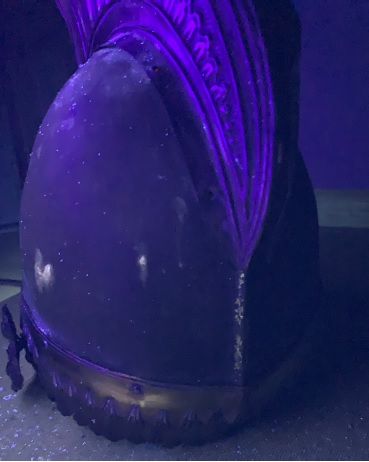March ’22
Dragoon Helmet

The object is a military helmet from the collections at Kiplin Hall. This particular helmet would have been worn by British 3rd Dragoon Guards, a heavy cavalry unit raised in 1685. This unit continued in British Army service until in 1922 the regiment was merged with the 6th Dragoon Guards (Carabiniers).
Both units were in India at the time. The new force was initially known as the 3rd/6th Dragoon Guards, but six years later it adopted elements of both predecessor regiment’s names, becoming the 3rd Carabiniers.

The style of this particular Dragoon Helmet was issued in 1812, however was replaced by 1818 with a new design which featured a bearskin plume. This particular helmet style displayed a shift in the design, as it was modelled after the Austrian crested helmets. It was also found to provide greater head protection than previous designs.
This specific helmet was an officers helmet, as identified by the gilded fittings; a soldiers helmet would have had brass fittings.
Condition
- The object had visible dirt on the surface, including several areas of dirt concretions
- There were signs of old polish residue on the leather as well as the metal
- The velvet strap was fragile and fraying
Conservation

Smokesponge was used initially to clean off as much dirt and polish residue as possible from the leather. Any large concretions of dirt were dislodged using a bamboo stick as this would not cause damage. After dry cleaning, there were still some areas of polish residue visible so solvents were tested on these areas to see whether they would remove the residue. Deionized water was determined to be the best option for wet cleaning and this was used with cotton swabs on the exterior including the top strip in the crest. Cleaning reduced the staining from polish but was not able to entirely eliminate it.

The metal was first cleaned using an appropriate solvent with cotton wool swabs in order to remove dirt and polish residues from the surface. There were several areas of encrusted dirt, and although there was a risk to the gilding by removing them, it was deemed acceptable as dirt can cause deterioration, and could attract pests. As solvents were ineffective at removing the areas of encrusted dirt, gentle mechanical methods were used.
The velvet textile was gently brushed to remove surface dirt, before a textile support was made using dyed silk crepeline in order to help prevent further deterioration of the fragile textile. Although these types of supports are usually sewn onto the original fabric, this particular support was adhered using a suitable adhesive as the textile was believed to be too fragile for sewing.
Stay tuned for next month’s object!
